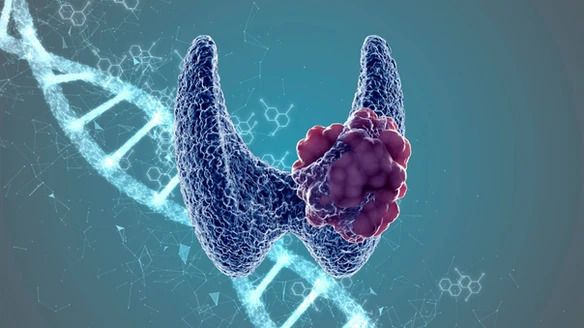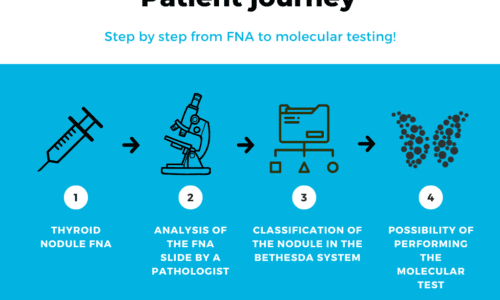- Marcos Santos, Ph.D
- 0 Comments
- 450 Views
The thyroid is a gland that regulates the function of organs such as the heart, brain, liver, and kidneys. To understand its importance, it directly influences the growth and development of children, menstrual cycle regulation, fertility, weight, memory, concentration, and even emotional control. To do so, it produces the hormones T3 (triiodothyronine) and T4 (thyroxine). When something is wrong with the thyroid, there can be an insufficient or excessive release of these substances, leading to problems that can occur at any stage of life¹. Let’s learn about the symptoms of the most common conditions.
Hyperthyroidism can alter heart rate
Hyperthyroidism occurs when there is an excessive production of thyroid hormones (T3 and T4). In its milder form, it only shows signs of weakness or discomfort. However, in its more severe aspect, the disease can even be life-threatening.
According to the Brazilian Society of Endocrinology and Metabolism, hyperthyroidism causes an increase in thyroid volume that can be associated with other symptoms, such as:
- Heart rate above 100 beats per minute (a condition called tachycardia);
- Irregular heart rhythm, especially in patients over 60 years old;
- Nervousness, anxiety, and irritability;
- Trembling and sweaty hands;
- Intolerance to hot temperatures and increased sweating;
- Hair loss and/or scalp weakness;
- Rapid nail growth with a tendency to peel;
- Muscle weakness, especially in the arms and thighs;
- Loose bowels;
- Significant weight loss;
- Changes in menstrual period;
- Increased likelihood of miscarriage;
- Staring gaze;
- Eye bulging, with or without double vision (in patients with Graves’ disease);
- Accelerated calcium loss from bones, increasing the risk of osteoporosis and fractures.
Causes of hyperthyroidism include Graves’ disease, goiter, the presence of a toxic nodule (producing more thyroid hormones than necessary), subacute, silent, or postpartum thyroiditis, excessive intake of iodine (present in seaweed tablets, expectorants, or in amiodarone, used in medications for cardiac arrhythmia), and overdose of thyroid hormones².
Weight gain can be related to hypothyroidism
Thyroid enlargement can also be observed in the case of hypothyroidism. However, this sign that something is wrong with the thyroid is not accompanied by increased hormone production, but rather the opposite: a decrease in T3 and T4 levels. Experts from the Brazilian Society of Family and Community Medicine explain that hypothyroidism is most commonly caused by an inflammation called Hashimoto’s thyroiditis, an autoimmune dysfunction. However, it can also affect newborns. In this case, the problem is diagnosed through the so-called heel prick test, and treatment should be initiated immediately. After all, a deficiency in the production of thyroid hormones affects the child’s development.
Like other thyroid disorders, hypothyroidism can affect both sexes, but it is more common in women. Therefore, endocrinologists recommend that women regularly perform self-examinations of the thyroid, especially after the age of 40. The most common symptoms of hypothyroidism include:
- Depression;
- Slowed heart rate;
- Constipation;
- Irregular menstruation;
- Decreased memory;
- Excessive fatigue;
- Muscle aches;
- Excessive drowsiness;
- Dry skin;
- Hair loss;
- Weight gain;
- Increased blood cholesterol.
Complications caused by hypothyroidism include anemia, coronary artery disease, gastrointestinal, neurological, endocrine, metabolic, and renal disorders. Respiratory dysfunctions, dyslipidemia, glaucoma, hypertension, heart failure, and, in the case of newborns, mental retardation and deafness are also common.
Goiter may be accompanied by nodules
A goiter may be an overall enlargement of the thyroid and is the main warning sign that something is wrong with the thyroid. Often, the condition presents nodules and is referred to as nodular goiter, which may or may not interfere with thyroid function. Nodular goiter is more common after the age of 50, when compressive symptoms in the thyroid region may arise (difficulty swallowing or hoarseness, for example). The problem can also be identified when associated with other gland dysfunctions, such as hyperthyroidism or hypothyroidism².
How to determine if something is wrong
If you identify with the symptoms indicating that something is wrong with the thyroid, it is important to see a doctor as soon as possible. Initially, the doctor will perform a neck palpation examination to check for an enlarged thyroid. Depending on the findings of this procedure and the reported complaints, further tests may be necessary³.
To evaluate thyroid function, doctors usually request blood tests to measure TSH, T3, and T4 hormone levels, as well as imaging tests (especially when one or more nodules are detected). If there is suspicion of thyroid cancer, a procedure called Fine-Needle Aspiration Biopsy (FNA) may be performed to assess whether the thyroid nodule is benign or malignant.
However, up to 20% of cases evaluated by FNA are indeterminate, meaning it is not possible to conclude whether the nodule is benign or malignant. Indeterminate nodules are those classified in the cytological examination of FNA as Bethesda III or IV. In these cases, the doctor may recommend thyroid removal surgery or, in some cases, request a molecular test that accurately classifies the nodule.
The mir-THYpe molecular classifier was developed in partnership with the Cancer Hospital of Barretos, a reference center for thyroid tumor diagnosis and treatment in Latin America, and uses artificial intelligence to classify the indeterminate thyroid nodules.
The procedure can help the doctor avoid unnecessary surgeries, improving the quality of life for those diagnosed with indeterminate thyroid nodules. If you are dealing with this issue, it is worth exploring! Discover everything your nodule can tell you, get to know the mir-THYpe molecular classifier!
References:
- Departamento de Tireoide da Sociedade Brasileira de Endocrinologia e Metabologia: http://www.tireoide.org.br/o-que-e-a-tireoide/
- Sociedade Brasileira de Medicina de Família e Comunidade: http://www.sbmfc.org.br/wp-content/uploads/media/NHG%2043%20Dist%C3%BArbios%20da%20gl%C3%A2ndula%20tire%C3%B3ide(1).pdf
- MSD and the MSD Manuals: https://www.msdmanuals.com/home/hormonal-and-metabolic-disorders/thyroid-gland-disorders/overview-of-the-thyroid-gland








